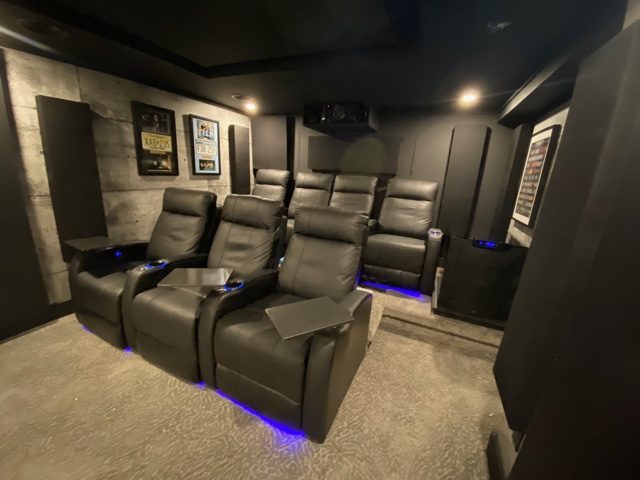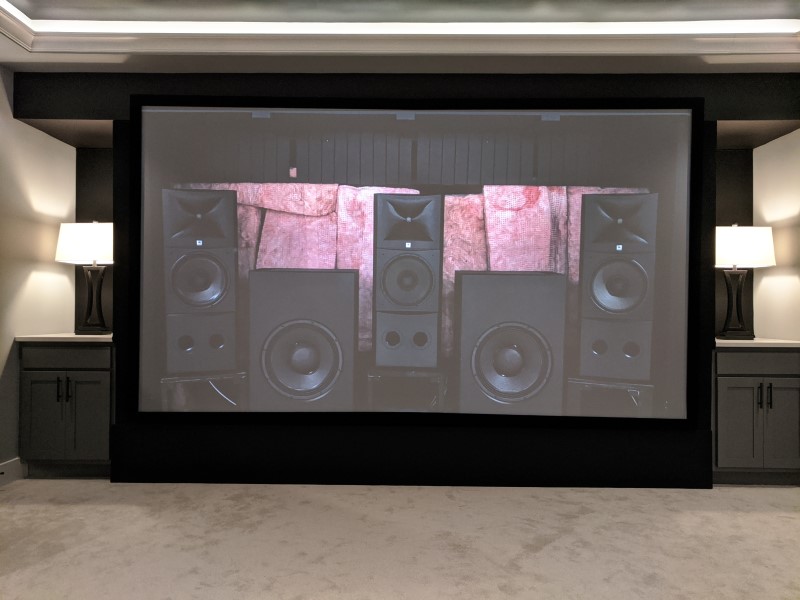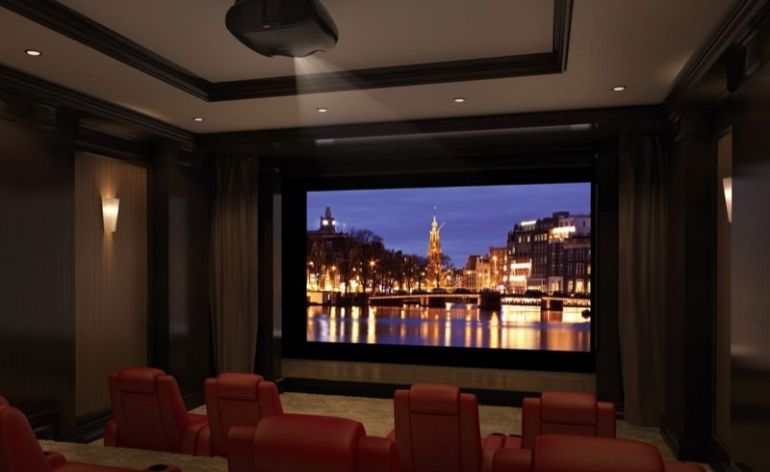Setting Up a Home Theater in a Very Large Room – Pros and Cons
If we all had infinite money, we’d probably have massive houses with our own screening room. Not just a home theater, but a full-fledged IMAX cinema. But we don’t. So we make do with what we have. Sometimes that means we set up our theaters in an extra bedroom. But, more often than not, we have to use a large, multi-use living space. These large rooms present many challenges for setting up your home theater. But it isn’t all bad. So here are some of the pros and cons of having a home theater in a very large room.
What Do We Mean by Large Home Theater Room?
That’s a great question. Before we go on, we need to define what we mean by a room. A room is all the air that is enclosed by doors and walls. So, in a bedroom, it is all the air that can be enclosed by a door. In a living room, it might be all the air that is in the living room, kitchen, hallways, and any other space that has air that can’t be closed off by a door. We do not call the space in a room that you have decided is going to be your home theater area a “room.” Since sound travels through the air, any air that is in contact with the air in the home theater, is part of the home theater room.
Types of Large Rooms
There are two types of large rooms that are often used for a home theater. The first is your great/living room. While the space carved out for the home theater may be quite small, the room itself is large. These spaces have unique challenges that we will touch on. So, if your home theater area is in your great room but it is also open to the kitchen, dining room, and a large hallway, all of that is included in the calculations for the “room.”
The other type of large room is simply a very large room. This most commonly occurs when someone has a large basement that they plan to renovate. Some people want to use the entire space for the home theater, but most want the room to have multiple uses. As we said, this includes all the enclosed space, even if you are using it for other purposes.
Pros and Cons of Using the Whole Room
I’ve never lived in a place where basements were commonplace. But I know they exist (from all the questions we get on the AV Rant Podcast). Basements may be the most common “man-cave” option, but there are plenty of people that have converted an exterior garage or mother-in-law apartment into a home theater. Attics are also often used. These spaces can be quite large.
Pros
If you have a large room, like a basement, and decide that you are going to use the entire space for your home theater, you’ve got a lot of things going for you. You’ll get to experience a very large screen, you can seat a lot of people, and you can get a more cinematic feel and sound from your space. With a massive room, you can more evenly place your speakers (using our recommendations, not Dolby’s) and you have plenty of space for all those surround, surround back, and overhead speakers everyone is wanting these days.

One of the biggest Pros of a large room is the flexibility. For that truly cinematic feel, you can set up a false wall for your screen and put your speakers behind it. You could even have a rear-projection setup completely hiding your projector (and moving it far away from you so you don’t hear the fans).
When you use an entire room for your home theater, regardless of size, you usually have carte blanche to make it into a theater. This means that you can paint it the color your want, acoustically treat it, and set it up however you want. You can truly make your room as good acoustically as possible while maximizing the picture quality. When you have control over the entire space, you can make it perfect. Be prepared to never go to the movie theater again!
Cons
The cons are fairly obvious and it mostly boils down to cost. A big screen with the appropriate projector costs a lot of money. If your room is so large that it needs a screen larger than 135″, you can no longer realistically buy a consumer-level projector and get an image bright enough for HDR. Projectors that cast images that large are very, very expensive and often have their own requirements (like a dedicated cooling system).
Beyond the image, you have to think about the sound. The farther away your speakers are from you, the more power they need to get to reference level. That means buying speakers that are very sensitive (horn-loaded or compression tweeters are the norm here) and usually very large. These types of speakers aren’t necessarily uncommon, but they do limit your choices. They also aren’t necessarily overly expensive, but many of the good ones are. You’ll likely need to mate them with external amps (rather than power them with an AV receiver). Plus, if your space is large enough, you’ll want multiple speakers playing the same content so that everyone has a convincing surround experience.

And we haven’t even gotten to subwoofers. To fully pressurize a very large home theater room, you need a lot of power. The subwoofers required will take up a lot of space and need a ton of output. They are out there, but they aren’t cheap. Next, you’ll need to deal with extra seats, risers so that everyone can see, extra room treatments, and lots more. All in all, it will cost more. But you knew that.
Summary
Everything will cost more, but you have free reign to make the best theater experience possible.
Using Part of a Large Room for Home Theater
Most of us have to use part of a larger room for our home theaters because we have no other option. We don’t have any other “extra” rooms in our homes (until a kid moves out) that we can convert into a home theater. Using part of a room has its own pros and cons.
Pros
The best part of using part of a large room for your home theater is that the gear will all cost less. You can buy a consumer-level projector or a large flat panel and get the same field of view you’d have in a movie theater. You can use bookshelf speakers instead of towers and they can hit reference level with a mid-tier AV receiver. Everything just costs less.
Beyond that, you have so many more choices. Most manufacturers assume that either you have a normal-sized room, or that you are sitting relatively close to your AV equipment. Flat panels are getting larger and less expensive, quickly encroaching on projectors. On top of that, Ultra Short Throw projectors are making it easier to get even a very screen set up in your room.

Perhaps the biggest pro is that you now have a home theater space. Most people don’t even have that. They settle for a TV and maybe a soundbar. What you have is so much better. You have true surround sound, access to all the latest video and audio formats, and you’ve taken the time to make your space as good as possible. It may not be “never go to the movies again” good, but it is way better than all of your friend’s spaces.
Cons
There are many small (and some large) issues with using a part of a room for your home theater. Many times, the theater part of the room is the afterthought. This means that you are often having to navigate around things that are already in place. This might be a fireplace, a picture on the wall, or the placement of windows. Even if you are in a large, open basement, many times the plan is for part of it to be the home theater and the other part to be something else. Game room, pool table, bar area…the list goes on.
Navigating the other things in your large room makes placing your home theater gear much more difficult. Finding a wall for a TV or a screen isn’t usually a problem. But placing those surround speakers? Surround speakers are often the hardest to place in a multi-purpose room. Either your couch is backed up to a wall or it is in the middle of the room with no walls on either side to mount them. This leads to compromised placement (like in-ceiling speakers for surrounds), compromised speaker choice, and compromised sound. And don’t get me started on trying to place two subwoofers correctly.

Speaking of subwoofers… No matter the size of your home theater space, the subwoofers need to pressurize the entire room in order to work properly. Honestly, you don’t want that. It will rattle every dish in your kitchen and make it nigh impossible to hold a conversation while the TV is on. So people look for alternatives like bass shakers. Sure, these can give you the illusion of bass by shaking your couch. But they are hard to set up properly and aren’t real bass. In the end, you won’t have the same sort of bass you’d get in a movie theater.
Lastly, acoustics always end up being a problem. No matter how many times I talk to people about printed acoustic panels, I can almost never get anyone to invest in them. This makes acoustically treating a multi-use space near impossible. More often. people refuse (usually because their significant other balks at the idea of adding things to the walls) and their acoustics suffer. There are things you can do to help the acoustics, but nothing works like actually treating the room. Often, that isn’t something people want to do in their living rooms.
Summary
Gear will cost less, bass, setup, and acoustics are much harder to get right.
Wrap Up
Carefully planning out any home theater is an important step to recreating the cinema experience at home. Having a large room presents many problems, but also opportunities. Don’t be afraid to use that large room. We are just helping you anticipate some of the issues you might run up against.


